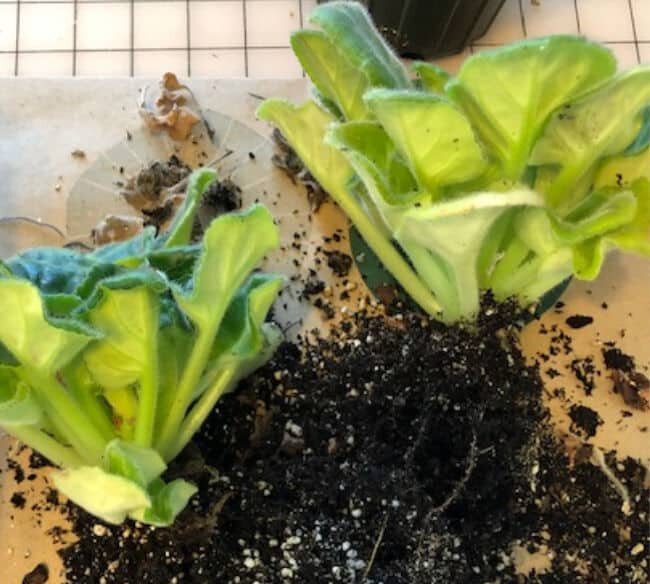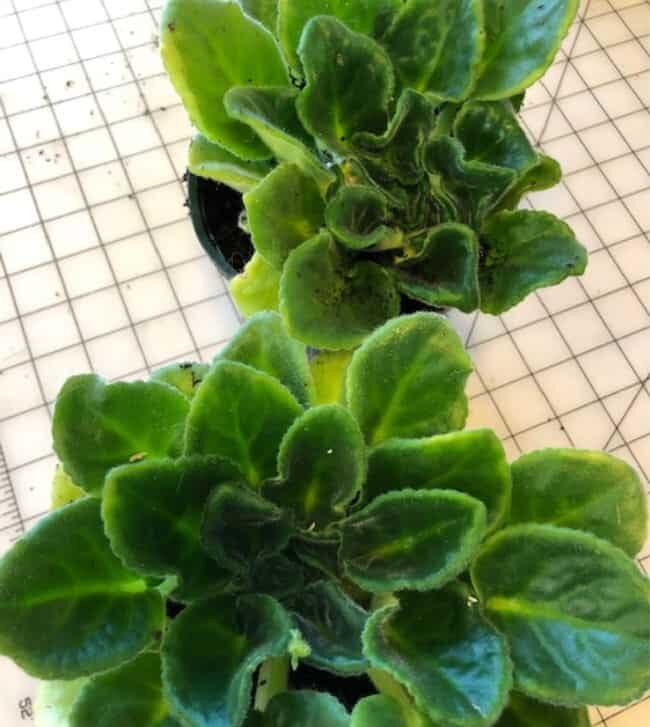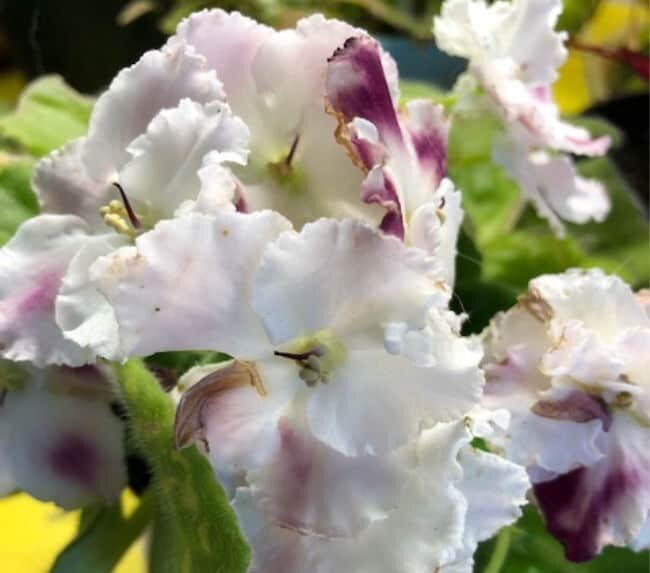How to Grow and Split African Violets
I think everyone should grow African violets. Why? Well, they’re really easy to grow (and split and propagate) as long as you follow a few easy guidelines (and if you don’t know what to do, check out my Growing African violets post here), and they’re pretty!
There’s such an amazing array of different flower colors ranging from pure white to pink to fuchsia to deep purple. There are even variegated ones, both flowers and leaves.
When you do grow them, though, after awhile you’ll notice that one of your plants may look like it has turned into two, right in the pot, like the one below.

How to Split Your African Violet
When that happens, it’s time to divide your violet and repot into separate pots. It’s a good idea to do this when the plant has divided in two, although you don’t have to rush to do it the second this happens.
I have to admit I once had a plant that I wasn’t really paying attention to and when I finally got around to repotting it, there were 7 (yes, SEVEN) plants in the pot! Needless to say, they became free gifts for friends and family, and as far as I know, they’re all still thriving!
So, how do you repot? It’s really easy, violets are very forgiving in this respect.
This post contains affiliate links. When you make a purchase through one of these links, I receive a small commission. This does not affect your purchase price.
Supplies you Need for Splitting your Violet Plants
First, get your supplies together. You can reuse the old pot for one of your repotted plants, if you want. Otherwise, make sure you have 2 appropriately-sized pots. Remember that violets don’t particularly like to be placed in very large pots, they prefer snug quarters. This set of 6″ pots is nice and very reasonably priced.
You’ll want to have some good quality potting soil available. This is really personal preference, although I do use an organic brand. Adding a bit of compost doesn’t hurt either.
Procedure for Splitting and Repotting
If your violet hasn’t been watered in awhile, giving it a bit of a drink so the roots are wet (or at least damp) and pliable is helpful.
Pull your plant gently out of the pot and lay it on your work surface. If there are any dead or sick-looking leaves underneath, gently pull those off. I sometimes pull off very large leaves as well because they’re old anyway and taking them off will allow the plant to put more energy into newer growth.

You may find, as I did with this plant, that you have to do very little work to get it apart. Mine was already so completely separated that I just pulled gently and it came apart. If you have waited too long, like I did that other time (7 plants!), they may be more entwined and you’ll have to work a little harder to get them apart successfully.
Obviously, you want to be gentle, but if you should break a few leaves, don’t worry, your plant is not going to suffer from this. Again, those are likely to be the older leaves around the outside or bottom, so taking them off may be helpful for your plant anyway.

Once your plants are separated, it’s as simple as putting potting soil in your pots, placing each plant in its own pot and tucking soil gently around the roots. Give it a good watering and place it in a sunny window (remember, no drafts!) and let it grow!

How to Propagate your African Violet
Maybe you have a friend with a violet you’ve really been admiring and you’d love to have one. Or maybe you’re like me and you purchased a violet with some variegated and some solid-colored leaves and you want to see if you can grow a fully variegated one.
Remember that plant that split into 7 plants? The original plant had solid-colored leaves and fuchsia flowers. When it split, one of the resulting plants had variegated flowers. The reason it did this has to do with some rather complicated genetics. Suffice to say, it’s kinda cool! You can see it in the pic below.

So, when I bought the plant with a few variegated leaves, I figured, why not see if I can get a fully variegated one? So, I took 3 or 4 of the variegated leaves and tried to propagate them.
Procedure for Propagating your Violet
How did I go about it? It’s actually really simple. Like, stupid simple. Either pinch or cut the leaf off leaving part of the petiole (that’s the stem the leaf is growing on). If the petiole is over 1 1/2 inches long, shorten it to under 1 1/2 inches.
Then, just make a small hole in a small container of potting soil and “plant” the leaf, patting the soil around it securely. Give it a gentle watering and that’s it. You’ll want to do a few of these as, sometimes, they don’t all take and the leaf rots.

At this point, you can just place your container where it will get bright, indirect light (direct, hot sunlight at this point isn’t a good idea since the leaf has no roots yet).
I think keeping the humidity high around my leaves as they start rooting is helpful, so I overturn an old 10-gallon aquarium over the pots until I see new growth, spritzing the underside of the aquarium with water every few days. As a bonus, it keeps the cats out of the pots until the plants are big enough to cover the soil! Here’s an aquarium, if you decide to go that route.
Patience, Grasshopper!
Now, here’s the hard part. You need to be patient! It takes some time for the leaves to root. The ones you see here have been in the soil for 3-4 weeks. When I (VERY!) gently tugged on the leaves today, there was resistance, which means roots are forming.
Even though the leaf has roots, I’m not going to see any new top growth for probably another 3 weeks, maybe even another month. Until then, I’ll keep them under the aquarium and in bright, indirect light.
Once I see new, small leaves forming, I’ll move the baby plants out of the aquarium and under my grow lights. I won’t repot until I see quite a bit of new growth several months down the line as they are still quite fragile at this time.
You may also notice as the new growth gets larger that the original leaf begins to rot away. That’s ok, it’s supposed to. Once it’s quite brown and new growth is well-established, you can cut or break the old leaf off.
How not to (apparently) Propagate your Violet
You may notice in the pic above that I planted a couple of pieces of leaves, as well as 2 full leaves with petioles attached. I did this because some plants will grow from chunks of leaves, especially if the center vein is exposed and placed into the soil. I’ve never heard of this working with violets, but figured I’d try. So far, there isn’t any growth on the leaves so I have a feeling it’s not going to work but I’ll leave them there for awhile just in case.

This is my collection of African violets. It keeps expanding because I have to split my plants! You might notice the one on the left still looks a little sick. If you read my other post on violets, I had one that had some cold damage because it was in a drafty window. That is the one. It’s actually looking much better than it did (you can see how it looked before in my African Violet post here).
Although the one on the bottom left looks damaged in the pic, that’s actually the variegated one and what you’re seeing is the variegation on the leaves.
You can also see a single bloom on the top right one. That’s the parent to the one in the middle with all the variegated blooms. Plant genetics can be weird!
I hope you’ve enjoyed this post and that it’s been helpful. Please leave any questions or comments, I love to read and answer them! Have you signed up for my email list yet? You can do that here. No spam, I promise! And don’t worry, you only have to sign up once. Once you’re subscribed, you’ll have access to ALL the freebies!
Related African Violet and Houseplant Posts
- Growing Healthy African Violets
- Caring for your Poinsettia
- How to Keep Pests out of your Houseplants
- The 4 Major Houseplant Pests and how to get rid of them
And if you have gardening friends, please do me a favor and share my little blog with them, I’d really appreciate it. Please pin one of the images below to your Houseplants or African Violets board so you can find it again.
As always, smile and have a crazy organic day!




6 comments
All my Violets are now three-in-one pot with some new babies looking very sad – you have given me great hope that I won’t kill them all.
Got some African Violet soil and ready to split them. I actually liked the look of 3 in 1, didn’t realize the plant was compromised, until they died…
They do like their own space. Just don’t transplant into pots that are too, too big. Violets like to be a little bit rootbound.
Hey Dawn,
What a great post you have here! Thanks.
Your article is incredibly informative. I love this. Plus, explaining how to split and propagate African Violets alongside pictures for each is just awesome.
This article is a ‘must share’ . Can’t go without sharing it so that several other gardeners may learn a thing or two.
Thank you so much! I appreciate the kind words and the shares!
Oh my! What a memory you have stirred up! My Granny converted her whole dining room to an African Violet nursery. It was the most beautiful spot I’ve ever seen. She had at least one of every color and was always propagating and giving them away… Now I have to go out and buy me an African Violet.
🙂 gwingal
Well of course you do! I’m working on getting one of every color, but because we’re deep in the middle of winter here, most garden centers aren’t open and I’ve been very disappointed in Home Depot’s selection.